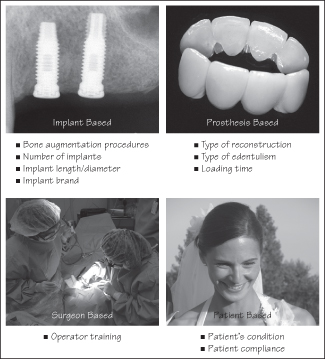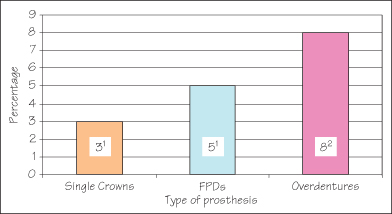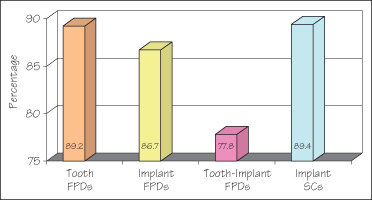9
Success, failure, complications, and survival
Different factors may influence implant longevity (Fig. 9.1). Therefore, from a statistical point of view, it is difficult to draw a definitive conclusion on the percentage of “success” of a dental implant. However, Figure 9.2 gives some data that provide a picture of the longevity of dental implants according to the type of reconstruction.
Figure 9.1 Factors that may influence implant longevity.

Figure 9.2 Estimated implant loss after 5 years of function according to the type of prosthesis
(data source: 1Lang et al., 2004; 2Berglundh et al., 2002).

The first attempts to evaluate dental implant “success” were the measurement of the overall survival of implants using life-table analyses. The statistical unit was the dental implant. Nowadays, the evaluation of dental implant success takes into account the lack of complication.
Dental Implants: The Best Treatment Option?
It is clear that the School of Bern (Switzerland) has produced the most accurate information on this topic. Regarding the single tooth replacement, there is no doubt that the implant single crown is the dominant strategy (less costly, more efficient and more cost-effective) when compared with tooth-supported FPDs (Bouchard et al., 2009; Popelut et al., 2010a). In other cases, the literature indicates that the success rate of dental implant therapies is predictable (Fig. 9.3).
Figure 9.3 Ten-year survival estimate of tooth-supported FPDs, implant-supported FPDs, tooth-implant FPDs, and implant-supported single crowns
(data source: Pætursson, 2008).

What Is a Success?
Taking into account that dental implant therapy is an elective procedure, a patient-centered approach may be the best choice in terms of evaluation. Thus, it seems that the modern definition of “success” can be simply stated as follows: A dental implant therapy is successful when there is no complication over time and when the patient is satisfied.
Nowadays, the definitions below, related to implant stability after surgical placement, are commonly used.
Success
Definition: the dental impla/>
Stay updated, free dental videos. Join our Telegram channel

VIDEdental - Online dental courses


